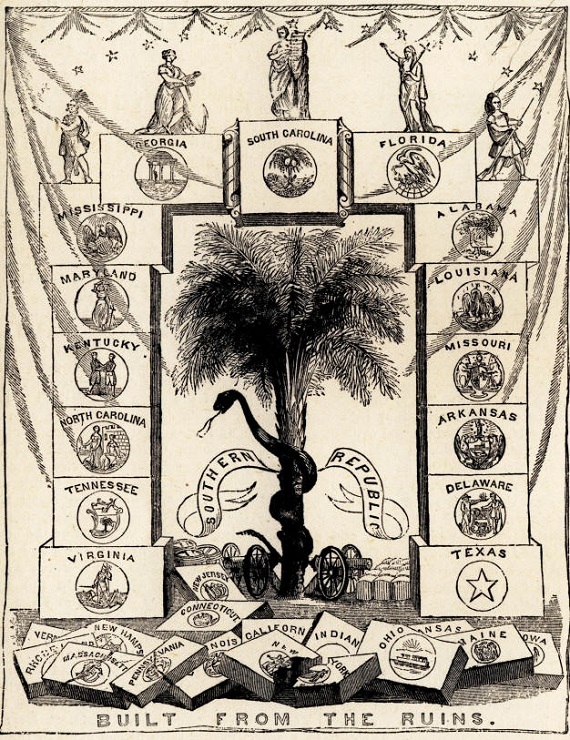If the lie did not begin with Ty Seidule, he popularized it in his 2015 Prager U. video:
“The secession documents of every single Southern state made clear, crystal clear, that they were leaving the Union in order to protect their peculiar institution of slavery.”
This falsehood is repeated regularly by the ignorant and informed alike. Seidule was the head of the History Department at The United States Military Academy. He knows the information below, so he is a liar. What follows is a brief description of the secession documents, ordinances, and declaration of causes (where they exist) for each of the 11 States that seceded and the official date. The States did not produce a common or standard set of documents.
South Carolina – December 24, 1860 Slavery was specifically cited after referencing 1852, where South Carolina “declared that the frequent violations of the Constitution of the United States, by the Federal Government” almost resulted in secession then. It would be fair to say slavery was front and center. “But an increasing hostility on the part of the non-slaveholding States to the institution of slavery has led to a disregard of their obligations, and the laws of the General Government have ceased to effect the objects of the Constitution”. The word “slavery” appears six times in the document, and it is alluded to in other places.
Mississippi – January 9, 1861 Mississippi’s declaration was about slavery. “Our position is thoroughly identified with the institution of slavery– the greatest material interest of the world. Its labor supplies the product which constitutes by far the largest and most important portions of commerce of the earth.”
Florida – January 10, 1861 The Florida Ordinance of Secession does not contain the word slavery, any derivative, or allusion. It declares that “the State of Florida hereby withdraws herself from the Confederacy of States existing under the name of the United States of America…”.
Alabama – January 11, 1861 The Alabama Ordinance of Secession alludes to slavery and only specifically mentions slavery in the form of inviting other “slaveholding” states to a convention of states “for the purpose of consulting with each other as to the most effectual mode of securing concerted and harmonious action in whatever measures may be deemed most desirable for our common peace and security.” The document cites the election of a “sectional party” that was “avowedly hostile to the domestic institutions and to the peace and security of the people of the State of Alabama”.
Georgia – January 19, 1861 Georgia is famously one of the four states who listed a declaration of causes. It is the most comprehensive and slavery took up the most space in the context of Constitutional violations. There was significant attention given to the preferences the central government gave to manufacturing and navigation interests and that “they received for many years enormous bounties by the general acquiescence of the whole country”.
Louisiana – January 26, 1861 The Louisiana Ordinance of Secession does not mention slavery or any derivative or contain any allusions to slavery. The first declaration was that “the union now subsisting between Louisiana and other States, under the name of ‘The United States of America’ is hereby dissolved”.
Texas – February 1, 1861 The Texas Declaration of Clauses begins with this: “The government of the United States, by certain joint resolutions, bearing date the 1st day of March, in the year A.D. 1845, proposed to the Republic of Texas, then a free, sovereign and independent nation, the annexation of the latter to the former, as one of the co-equal states thereof…”. This sets the stage for the rest of the document which argues the United States is not abiding by that agreement. Significant in the discussion is slavery, but it is not the only Constitutional grievance. “They have impoverished the slave-holding States by unequal and partial legislation, thereby enriching themselves by draining our substance.”
A Little Context—The states above were the first seven to secede. The next four would not secede until after Fort Sumter and Lincoln’s call for troops “in order to suppress” the States “too powerful to be suppressed by the ordinary course of judicial proceedings or by the powers vested in the marshals by law.” Virginia was next, a few days after Sumter, and Tennessee was last, six months after South Carolina.
Virginia – April 17, 1861 The Virginia Ordinance of Secession is a legalistic document that references other slaveholding States: the “Federal Government having perverted said powers, not only to the injury of the people of Virginia, but to the oppression of the Southern slaveholding States”. There is no other reference to slavery.
Arkansas – May 6, 1861 The Arkansas Secession Ordinance essentially says that they warned the US Government that if coercion was used against States that had seceded, Arkansas would secede. They were good to their word. Slavery is not mentioned.
North Carolina – May 20, 1861 The title of the North Carolina ordinance says all you need to know: “An Ordinance to Dissolve the Union Between the State of North Carolina and the Other States United with Her Under the Compact of Government Entitled the Constitution of The United States.” The ordinance does not mention slavery.
Tennessee – June 8, 1861 The State of Tennessee unashamedly called on the Declaration of Independence as their basis for secession instead of arguing the legality of the same. Here is the title of the document. “Declaration of Independence and Ordinance Dissolving the Federal Relations Between the State of Tennessee and the United States of America.” There was not one mention of slavery.
Conclusion—The lie that every Southern States’ secession documents made it “crystal” clear that their separation from the Union was because of slavery is persistent. Some will say that allusions to slavery still count as slavery being the cause. Please refer to the beginning of the document. An allusion is not crystal clear, by definition, or in reality. The reality is that there were many Constitutional issues outside of slavery. Besides, even with the easier standard of accepting allusions to slavery, it only takes one not to allude to slavery for it to be a lie. There are several, and modern historians know this. Face it. Ty Seidule lies.







BT Washington. “There does not exist on the face of the earth a group of blacks in a better position than those who went thru the slave system in the United States.
A handy primer to have. I’m going to print it and add it to the file with summaries proving Thomas Jefferson did not father slave children. I’ve used it various times and am answered with, Well that’s not what Monticello says.
As in Tom Jefferson’s case, it will make little difference. The narrative is ironclad. If none of the seceding states mentioned slavery but minutes of just one secession convention mentioned that slavery was struck from the ordinance it would be as if all states promoted slavery. “See?! Right here! Slavery!!
That’s not resignation, only understanding the threat before contact with the enemy.
People like Seidule know what they are doing. They have little interest in the truth. If you notice you will see that these people seldom ask. They mostly tell. Not sharing, which requires questions, but telling from an unannounced source. If they did not lie, they could not tell.
You got that right. Like the leftist activists on TV. They’re there only to repeat their narrative. They get away with it every time.
That’s all seidule is, isn’t it? A leftist activist. (His name isn’t capitalized on purpose. It’s getting so I can’t utter the names and places.)
did any of the slave union states have declarations of union-ism while maintaining slavery?
additionally…in the declarations that included slavery, did other issues also repeat? tariffs, threats, etc.
While it’s clear from the above that slavery was a factor in secession, it’s crystal clear that the North’s invasion and war against the South was not motivated by the desire to end slavery.
It’s very surprising some made no allusion to it at all. Afterall, slavery was entirely legal under the Constitution and (like it or not), a better legal argument at the time would be very much to include the right for the existence of slavery within any separation document.
Very good synopsis sir, and thank you for the truth.
I would like to know how many Congressional statutes and resolutions were passed from 1781 to 1860 prohibiting the US Treasury from accepting any monies collected from or based on or related to the use of slave labor.
heh…they were pretty busy sending slave ships abroad for the global trade.
Great summary, I will save this for future use – in my discussuins with folks who oppose Confederate memorials. Have to add that I went to war. I looked at not one piece of paper before deciding to raise my hand. Its silly to think these secession documents “prove” anything ther than some politicians felt the need to write things.